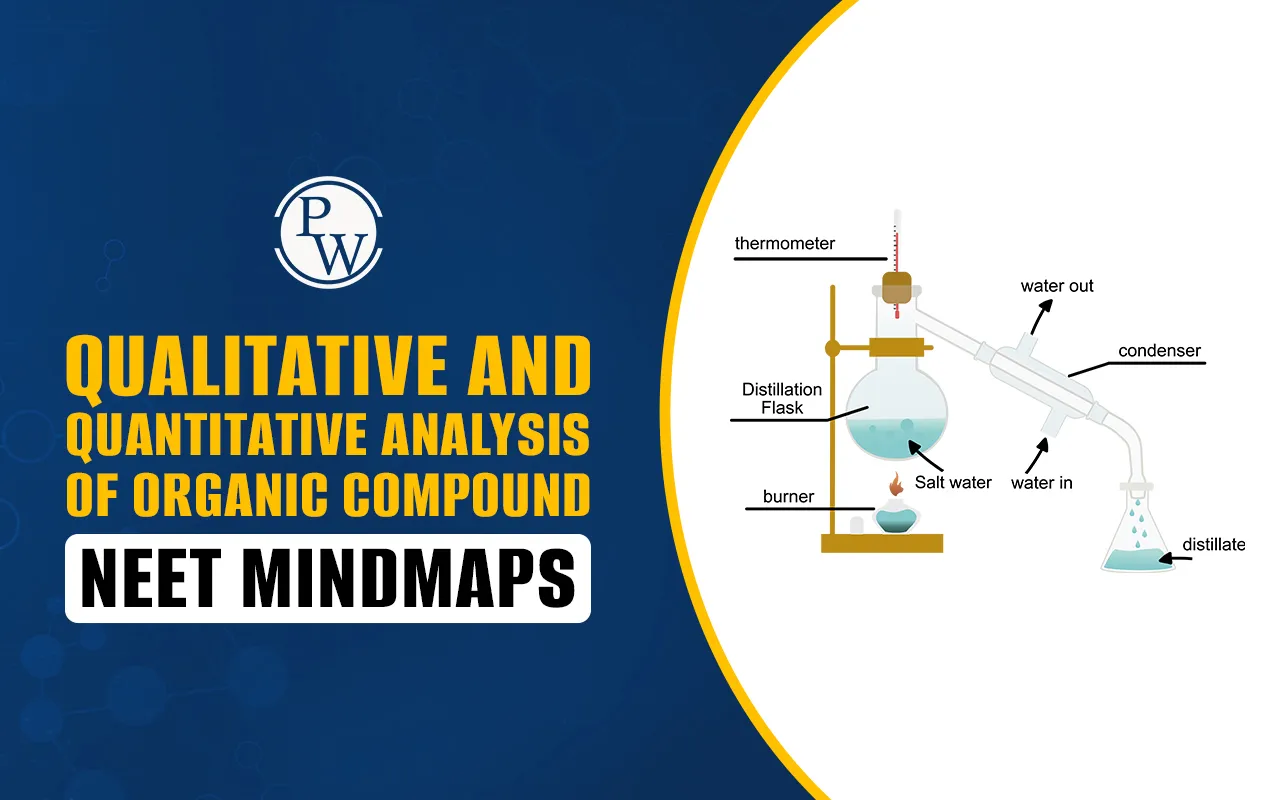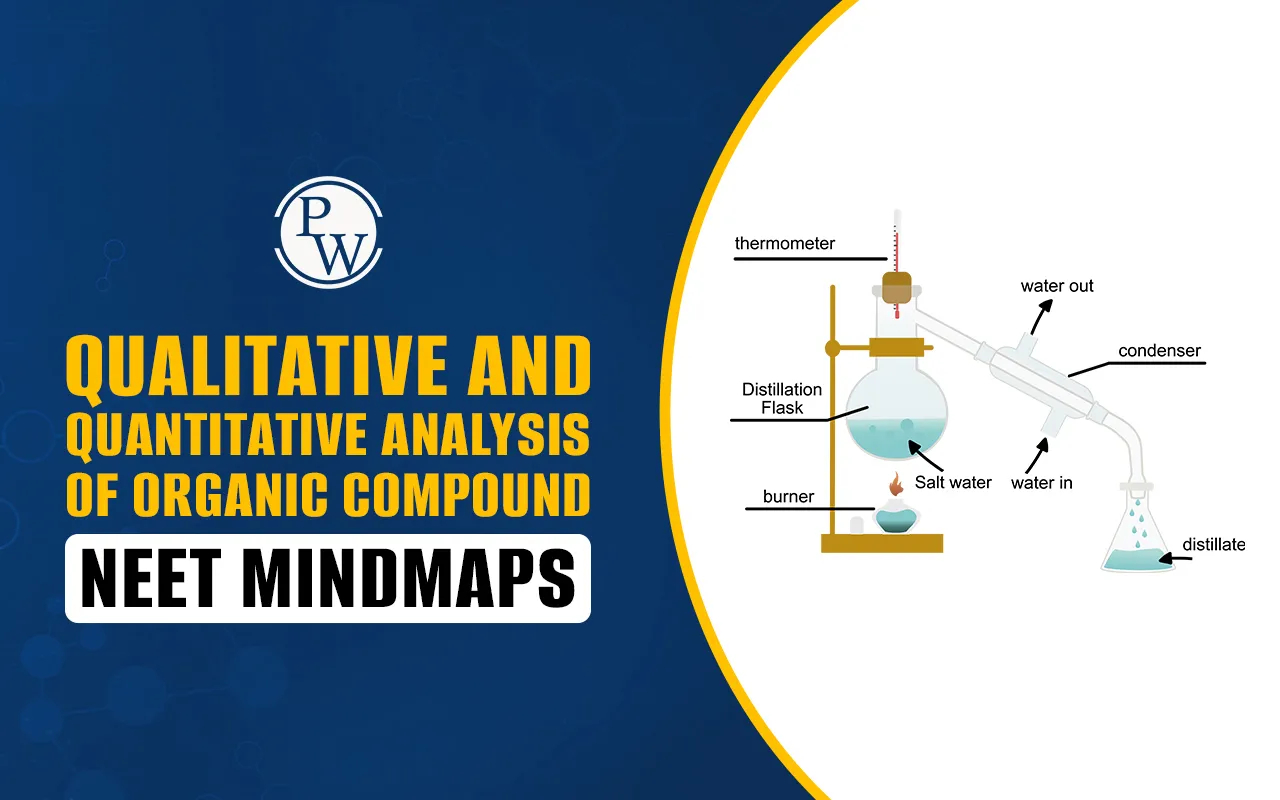

Qualitative and Quantitative Analysis: The analysis of organic compounds is an important chapter in NEET Chemistry. It covers both qualitative and quantitative methods. You should prepare this concept well as it helps in identifying functional groups, determining molecular formulas, and analyzing elemental composition.
Qualitative and Quantitative Analysis of Organic Compound NEET Mindmap simplify this topic by visually summarizing all reactions, detection methods, and calculations in a concise format. Using this mindmap, you can revise key reactions, identify functional groups, and remember formulas efficiently.
Qualitative and Quantitative Analysis of Organic Compound NEET Mindmap Notes
The mindmap notes organize the chapter into easy-to-revise sections. This will help you quickly grasp key concepts:
|
Qualitative and Quantitative Analysis of Organic Compound NEET Mindmap Notes |
||
|
Topic |
Details |
Example / Notes |
|
Qualitative Analysis |
Identifies functional groups in organic compounds using characteristic reactions. |
Functional groups include –OH, –COOH, –CHO, –C=O, –NH₂, etc. |
|
Tests for Functional Groups |
- Alcohols: Lucas test, chromic acid test - Aldehydes/Ketones: Tollen’s test, Fehling’s test - Carboxylic acids: NaHCO₃ test - Amines: Hinsberg test |
Helps determine the type of functional group present in a compound. |
|
Quantitative Analysis |
Determines elemental composition and molecular formula. Includes mass analysis, combustion analysis, and percentage composition calculations. |
Example: Determining C, H, O content to calculate molecular formula. |
|
Molecular Formula Determination |
Based on empirical formula and molar mass. |
Empirical formula → CnHmOpC_nH_mO_pCnHmOp, Molar mass known → molecular formula. |
|
Characteristic Reactions |
Shows typical reactions for functional groups. |
e.g., Alcohols oxidize to aldehydes/ketones; Carboxylic acids react with metals to release H₂. |
|
Limitations and Precautions |
Notes common errors in qualitative tests and importance of pure samples. |
Ensures accurate identification and prevents false results in experiments. |
Qualitative and Quantitative Analysis of Organic Compound NEET Mindmap Formulas
Formulas play an important role for quantitative analysis and NEET calculations. High-yield Qualitative and Quantitative Analysis of Organic Compound NEET Mindmap Formulas include:
|
Qualitative and Quantitative Analysis of Organic Compound NEET Mindmap Formulas |
|
|
Concept |
Formula / Relation |
|
Empirical formula |
Simplest whole-number ratio of elements in a compound |
|
Molecular formula |
Molecular Formula=n×Empirical Formula\text{Molecular Formula} = n \times \text{Empirical Formula}Molecular Formula=n×Empirical Formula where n=Molar massEmpirical formula massn = \frac{\text{Molar mass}}{\text{Empirical formula mass}}n=Empirical formula massMolar mass |
|
Percentage composition |
%Element=Mass of elementMass of compound×100\% \text{Element} = \frac{\text{Mass of element}}{\text{Mass of compound}} \times 100%Element=Mass of compoundMass of element×100 |
|
Combustion analysis |
Used to determine C and H content from CO₂ and H₂O produced |
|
Mass analysis |
Relates sample mass to moles of elements for molecular formula calculation |
Qualitative and Quantitative Analysis of Organic Compound NEET Mindmap PDF
Qualitative and Quantitative Analysis of Organic Compound NEET Mindmap PDF combines the entire chapter into a one-page visual summary:
-
It includes functional group tests, reactions, empirical/molecular formula determination, and quantitative analysis methods.
-
You can quickly identify key functional groups, memorize reactions, and revise calculation formulas easily.
It will help you connect qualitative tests with quantitative methods, strengthen memory retention, and solve both theoretical and numerical problems efficiently. Below is the Qualitative and Quantitative Analysis of Organic Compound NEET Mindmap PDF:
Qualitative and Quantitative Analysis of Organic Compound NEET Mindmap PDF
Qualitative and Quantitative Analysis of Organic Compound NEET Mindmap Practice Questions
Mindmaps link functional group tests, reactions, and formulas, allowing students to revise and practice simultaneously for NEET. Qualitative and Quantitative Analysis of Organic Compound NEET Mindmap Practice Questions will reinforce understanding and speed:
-
Identify functional groups using given qualitative tests.
-
Determine empirical and molecular formulas from elemental composition.
-
Calculate percentage composition of elements in a compound.
-
Predict products of characteristic reactions for alcohols, aldehydes, ketones, and carboxylic acids.
-
Solve combustion analysis problems to determine C and H content.
Tricks to Revise with Qualitative and Quantitative Analysis Mindmaps
Revising organic analysis requires a strategic approach to reactions and calculations:
-
Group functional tests visually, i.e., use the mindmap to cluster –OH, –CHO, –COOH, –NH₂, and other groups for quick identification.
-
Remember how a positive test (e.g., Lucas test) corresponds to a reaction with a reagent.
-
Use stepwise calculation shortcuts, for molecular formula determination, memorize the relation between empirical formula, molar mass, and n.
-
Color-code qualitative vs quantitative sections will help you differentiate tests from formula-based calculations.
-
Solve mindmap-based questions repeatedly to reinforce both functional group identification and quantitative problem-solving.
-
Relate functional group tests with elemental composition for better conceptual understanding.
